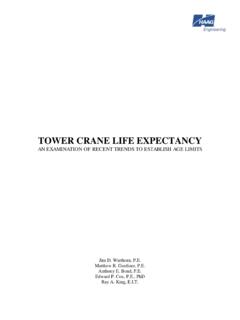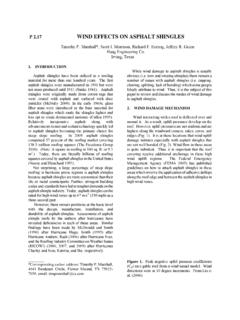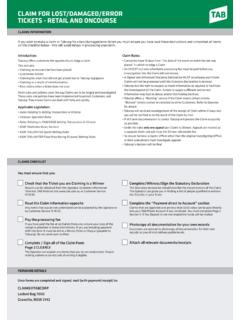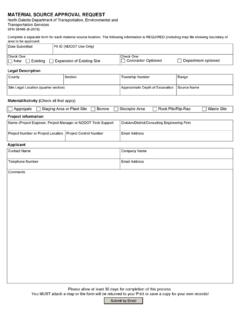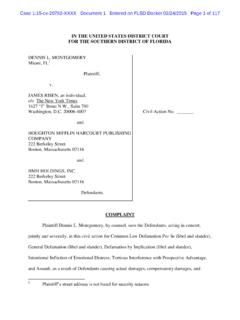Transcription of Proceedings of the North American Conference on …
1 Proceedings of the North American Conference on roofing Technology41 The authors firm has performed impact tests of manyroofing materials since 1963. The first study involved theeffects of hail damage to wood shingles and shakes. At theconclusion of the 10-year study, a summary of test resultswas published [12]. In 1983, the study was expanded toinclude the effects of hail on asphalt shingles, fire-retar-dant-treated wood shingles and shakes, fiberboard panels,and aluminum panels. Meteorologists at the author s firmhave conducted storm surveys of major hailstorms anddeveloped software programs that search historical databases for hail-fall records and analyze the risk of damaginghail in the continental United PROCEDUREThe assessment procedure is b ased on determiningwhether there is hail-caused damage and if so, quantifyingthe amount of damage on each roof slope.
2 It also involvesdetermining whether repair of individual shingles orshakes or roof system replacement on an entire slope (orroof) is the economical choice. The first step is to inspectthe roof system and differentiate hail damage from non-hail damage. Functional damage to roofing materials fromhail has been defined as the diminution of water-sheddingcapability or reduction of the expected service life of theroofing material [13]. The second step is to quantify thedamage on each directional slope by examining test third step is to determine through a repair cost formu-la whether repair or replacement of the roofing material OF HAIL-CAUSED DAMAGEA sphalt ShinglesHail-caused damage to an asphalt shingle in roofing is rup-ture of the reinforcing mat or displacement of granules suf-ficient to expose underlying bitumen [14].
3 The former is apenetration of the shingle that, in effect, removes a ply ofroofing and has the potential for water to reach the fasten-ers or butted joints in the underlying shingle. The latterrepresents a potential loss of expected service life of theshingle. However, we are not aware of any studies to datethat have demonstrated a quantifiable loss of shingle lifewhere the bitumen is exposed to the weather. Rupture of the reinforcing mat involves either bruising,which can be felt as a soft spot on the shingle (much likean apple bruise), or puncturing where there is a hole inthe mat. Bruises are soft areas large enough to be detectedby finger pressure and generally are accompanied by a suf-ficient loss of granules within the impact area to exposethe underlying bitumen (Figure 3).
4 Bruises in field shin-gles often occur in the less-supported areas of the shingles,such as along ridges, valleys, and overhanging roof edgesor above the tops of shingle head laps, (about 2 inches [52 mm]) from shingle butt edges). Our field experienceand laboratory testing have shown that punctures or bruis-es in asphalt shingles rarely occur with hailstones less than1 inch (25 mm) in diameter, unless the shingle is poorlysupported and deteriorated. Generally, we find hard iceballs that impact perpendicularly can damage weatheredasphalt shingles when they are 11 4inches (32 mm) in diam-eter and new shingles when 11 2inches (38 mm) in diame-ter [15]. Similarly, Greenfeld and Koontz have found thatimpact-caused fractures in new shingles occur with icespheres in a range from 11 4inches (32 mm) to 21 4inches(58 mm) in diameter depending on shingle product andsupport conditions [16, 17].
5 Large hailstones produce matfractures or bruises close to the diameter of the hailstoneespecially where the shingle has less underlying some instances, granules are dislodged from the shin-gles to expose bitumen without shingle mat rupture. Minorgranule loss caused by a hailstone impact that does notresult in the exposure of the shingle bitumen has not beenfound to cause any measurable loss of service life for theimpacted shingle [15]. Chipped shingle edges do notshorten shingle service life and, hence, generally are notincluded in the shingle damage of shingles that have bitumen or mat exposedmust be examined to determine whether the damage wascaused by hail or any other factors. Mechanically causedmarring of shingles during shipping, handling and installa-tion can disturb the granule surfacing enough to displaceand expose bitumen.
6 This is true particularly for warmfiber glass shingles subject to foot traffic on the roof. Mar-ring results in a ridge of bitumen and granules at theperimeter of the mark that is not found in hail-causeddamage (Figure 4). Patterns of weathering or manufactur-ing deficiencies can result in areas of little to no granulecoverage on the shingles. Bundle variations should be rela-tively easy to detect because the affected shingles would bearranged in diagonal or straight-up columns. In contrast,exposed areas of asphalt caused by hailstone impact wouldbe roughly circular in shape and randomly distributed inthe shingles. Blistering may appear as small bubblelike fea-tures in the granule crust whose tops weather away to leavepits in the shingles; the pits have steep sides and oftenextend to the mat.
7 Granule flaking from old organic shin-gles can appear as areas of exposed bitumen that have aweathered gray color (Figure 5). Therefore, the overallcondition of the shingles on the roof must be evaluated todifferentiate between hail-caused damage and other typesof number of findings have been documented in our lab-oratory studies and confirmed in our field inspections ofhow impact-caused fractures in the mats weather [15]. Thebitumen exposed in a recently caused hail impact will havea shiny black color. The bitumen weathers through photo-oxidation from a black to light-gray color over fractures in shingles initially have sharpFigure in a fiber glass composition shingle from hail Proceedings of the North American Conference on roofing Technologyedges that, over time, weather to rounded forms.
8 The over-all size of the damaged area does not increase measurablyeven after years of exposure. In fractured organic mat shin-gles, the shingle mat will shrink and curl back from thefractured area over a period of years. With fiber glass-rein-forced shingles, fractures widen but do not propagate visi-bly. The author s firm conducted a study on asphalt shinglesthat delineated hail-caused impacts from ball-peen ham-mer impacts intended to simulate hail damage [18]. Ham-mer impacts usually involved crushing or breaking of thegranule surfacing on the shingles whereas hailstoneimpacts do not. Also, hammer impacts leave marks that areroughly the same size and shape regardless of roof slope,whereas hail-caused impacts are of various sizes, shapes andimpact angles.
9 Furthermore, people tend to cluster ham-mer impacts in the middle portion of the shingles or roof,whereas hail impacts are distributed randomly on the shin-gles or Shingles and ShakesHail-caused damage to wood shingles and shakes is definedas a split or puncture in the wood caused by hailstoneimpact [12]. Hail impacts in wood leave recognizableimpact marks where some of the gray-colored oxidationand/or organic surface growths have been cleaned away. Ahail-caused split in the wood is indicated by an impactmark coincident with a fresh split in the wood (Figure 6).Wood splits from hail impact occur at the moment ofimpact, and impacts that do not split the wood ( , spots,dents, gouges) are not considered damaged . Long-termnatural weathering studies following impacts with simulatedhailstones have confirmed that impact marks without initialsplitting do not create a potential for future splitting [19].
10 A hail-caused split in a wood roof system does not meanthat a leak will occur at that split because there are addi-tional layers of wood protection (and interlacing felt on ashake roof system); however, the potential for split align-ments with other splits or joints between shingles or shakesand loss of pieces of the shingle or shake justify classifyingthe split as damage requiring remedial work. A hail impactsufficient to puncture the wood, most commonly found inthin areas of shakes, also is damage because it involves theloss of one layer of roofing . Impacts by hailstones do notaffect the fire or moisture resistance of pressure-treatedwood or promote fungus or lichen growths or algae stain-i n g .There are several characteristics that distinguish splitscaused by hail impact from those due to natural weather-ing.
